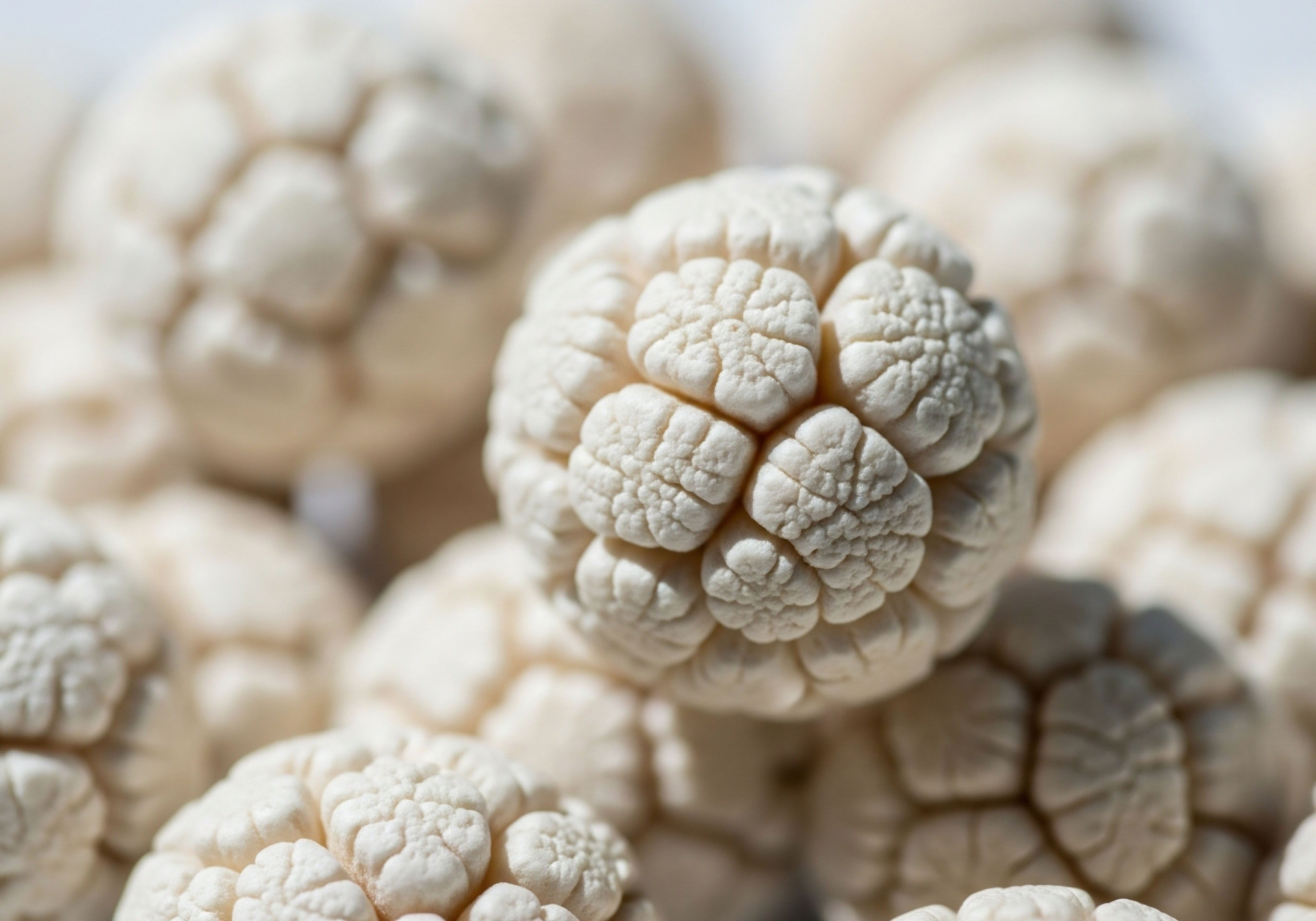

Fundamentals
The moment arrives when the external support of testosterone replacement therapy ceases. A distinct quiet settles within the body’s internal communication systems. This silence can be unsettling, filled with questions about how your own biological machinery will restart, how muscle will be maintained, and how vitality will be reclaimed through your own efforts.
The experience is deeply personal, a transition from a state of managed hormonal stability to one of self-directed biological revival. The path forward is paved with the choices you make in the kitchen and the gym, which together form the primary language your body will use to restart its own endocrine conversation.
At the center of this restart is a sophisticated network known as the Hypothalamic-Pituitary-Gonadal (HPG) axis. Think of it as an intricate communication system connecting three key command centers ∞ the hypothalamus in the brain, the pituitary gland just below it, and the gonads.
During testosterone replacement, this internal system becomes dormant because the body detects sufficient hormone levels from an external source. The challenge post-TRT is to gently and effectively awaken this network, encouraging it to resume its natural rhythm of signaling and production. Dietary interventions are the foundational tools for this process, supplying the precise molecular building blocks and energetic resources required for the system to reboot and function optimally.

The Blueprint for Hormonal Production
Your body’s ability to synthesize its own testosterone is a process of biochemical construction. It begins with cholesterol, a molecule that serves as the universal precursor for all steroid hormones. From this starting point, a series of enzymatic conversions, collectively known as steroidogenesis, transforms cholesterol into testosterone. This entire manufacturing line depends on a steady supply of specific raw materials provided directly by your diet. The quality of these materials dictates the efficiency of the entire process.
Healthy fats are indispensable, providing the foundational cholesterol and fatty acids necessary for hormone creation. Sources like avocados, olive oil, nuts, and fatty fish deliver the types of lipids that support cellular health and hormone synthesis. Concurrently, specific micronutrients function as essential cofactors, acting like skilled workers on the assembly line.
Zinc, for instance, is vital for the function of enzymes that produce testosterone. Magnesium and Vitamin D are also deeply involved, supporting hundreds of metabolic reactions that contribute to hormonal balance and overall physiological readiness. A diet lacking in these key components is akin to trying to run a factory with an inconsistent supply of raw materials; the production of the final product will inevitably be compromised.
A nutrient-dense diet provides the fundamental biochemical vocabulary required to re-establish the body’s natural hormonal dialogue after TRT.
Exercise, particularly resistance training, sends a powerful demand signal to the body, indicating a need for muscle repair, growth, and the hormonal support required for these adaptations. This signal is received most clearly when the body is nutritionally prepared to respond. The synergy between a targeted exercise regimen and a supportive dietary protocol creates a powerful feedback loop.
The exercise creates the demand, and the diet provides the capacity to meet that demand, encouraging the HPG axis to ramp up its activity and restore endogenous testosterone production to support the new physiological requirements.


Intermediate
Moving beyond the foundational understanding of nutrient requirements, we arrive at the clinical strategy of building a metabolic architecture conducive to hormonal recovery. This involves a more granular approach to nutrition, where the timing, ratios, and sources of macronutrients are calibrated to support the specific biological processes of post-TRT adaptation.
The objective is to create an internal environment characterized by metabolic efficiency, low inflammation, and optimal signaling within the HPG axis. This is where diet transitions from a simple source of fuel to a sophisticated tool for biological regulation.
The effectiveness of your post-TRT exercise regimen is directly tied to the body’s ability to manage inflammation, control insulin sensitivity, and provide a consistent stream of amino acids for muscle protein synthesis. A well-formulated dietary plan addresses all three of these domains simultaneously.
It provides the building blocks for tissue repair while actively managing the biochemical stressors that can hinder the restart of the HPG axis. The interplay between your nutritional intake and your training stimulus becomes a daily exercise in systemic calibration.

Macronutrient Strategy for Hormonal Restart
The orchestration of protein, fats, and carbohydrates is central to creating a supportive metabolic state. Each macronutrient plays a distinct role in hormonal health and exercise recovery.
- Protein Your protein intake is the cornerstone of muscle preservation and growth. Following the cessation of TRT, maintaining lean body mass is a primary objective. A daily intake of approximately 1.4 to 2.2 grams of protein per kilogram of body weight supplies the necessary amino acids to repair muscle tissue damaged during exercise. High-quality sources such as lean meats, fatty fish, eggs, and legumes ensure a complete amino acid profile, which is essential for both muscle synthesis and the production of neurotransmitters that regulate pituitary function.
- Fats Dietary fats provide the literal building blocks for testosterone. Cholesterol, derived from sources like eggs and saturated fats, is the primary precursor molecule in the steroidogenesis pathway. Monounsaturated and polyunsaturated fats, found in avocados, nuts, seeds, and olive oil, are crucial for maintaining the health of cell membranes, which allows for efficient hormone signaling. Omega-3 fatty acids, particularly from fatty fish like salmon, help to manage systemic inflammation, a key factor that can suppress HPG axis function.
- Carbohydrates Carbohydrates are the primary fuel for high-intensity exercise and play a role in managing cortisol, a stress hormone that can interfere with testosterone production. Chronic stress or intense training without adequate carbohydrate intake can elevate cortisol, creating a catabolic environment that undermines both muscle growth and hormonal recovery. Sourcing carbohydrates from whole foods like sweet potatoes, oats, and vegetables provides sustained energy and fiber, which supports gut health and further reduces inflammatory load.

Micronutrient Cofactors the Unsung Heroes
While macronutrients build the structure, micronutrients enable the function. Several vitamins and minerals are critical for restarting and maintaining endogenous testosterone production. Deficiencies in any of these can create significant bottlenecks in the hormonal production pathway.
- Zinc This mineral is a direct participant in testosterone synthesis. It acts as a cofactor for enzymes within the Leydig cells of the testes, where testosterone is produced. Zinc deficiency is strongly correlated with impaired testosterone production. Oysters are the most concentrated source, with red meat, shellfish, and pumpkin seeds also providing significant amounts.
- Vitamin D Often called the “sunshine vitamin,” Vitamin D functions as a steroid hormone itself and is essential for male reproductive health. Research indicates a strong link between adequate Vitamin D levels and healthy testosterone concentrations. Fatty fish, fortified dairy products, and eggs are good dietary sources, though supplementation may be necessary depending on geography and sun exposure.
- Magnesium This mineral is involved in over 300 enzymatic processes in the body, including those related to energy metabolism and muscle function. It also appears to play a role in increasing the bioavailability of testosterone by influencing its binding to sex hormone-binding globulin (SHBG). Leafy green vegetables, nuts, seeds, and whole grains are excellent sources of magnesium.
Strategic macronutrient partitioning and micronutrient sufficiency create the ideal biochemical environment for the HPG axis to respond to exercise-induced stimuli.
| Framework | Protein Goal (g/kg) | Primary Fat Sources | Primary Carb Sources | Mechanism of Action |
|---|---|---|---|---|
| Balanced Intake | 1.6 – 2.0 | Avocado, olive oil, nuts, seeds, fatty fish | Sweet potatoes, quinoa, oats, fruits, vegetables | Provides sustained energy, ample amino acids, and anti-inflammatory fats to support overall metabolic function and recovery. |
| Carb Cycling | 1.8 – 2.2 | Coconut oil, grass-fed butter, fatty fish | White rice, potatoes (on training days); leafy greens (on rest days) | Maximizes insulin sensitivity and glycogen replenishment around workouts while promoting fat adaptation on rest days. |
| Targeted Ketogenic | 1.5 – 1.8 | MCT oil, avocados, eggs, nuts, seeds | Leafy greens, broccoli, cauliflower, berries (limited) | Minimizes insulin spikes and inflammation, providing a stable energy source from ketones while supplying fats for steroidogenesis. |

How Does Diet Influence Hormonal Signaling in China?
When considering dietary protocols within a specific cultural context, such as in China, it is important to recognize the interplay of traditional food patterns and modern dietary shifts. Traditional Chinese diets, often rich in vegetables, rice, and soy, can be adapted to support hormonal health.
Emphasizing cruciferous vegetables like bok choy and broccoli can aid in estrogen metabolism. However, the increasing prevalence of processed foods and seed oils in modern Chinese diets presents a challenge, as these can promote inflammation and insulin resistance, thereby potentially hindering HPG axis recovery. A successful dietary strategy in this context would involve integrating traditional, nutrient-dense foods while consciously limiting modern, pro-inflammatory options.


Academic
A sophisticated analysis of dietary influence on post-TRT exercise regimens requires moving beyond general nutritional advice to a deep examination of specific biochemical pathways. The efficacy of any recovery protocol is fundamentally governed by the body’s underlying metabolic state.
Two of the most powerful and dietarily-modifiable regulators of the HPG axis are insulin sensitivity and aromatase enzyme activity. Mastering these two levers through precise nutritional intervention provides a direct mechanism for optimizing the hormonal environment, thereby maximizing the anabolic response to resistance training and facilitating a more robust return of endogenous testosterone production.
The entire post-TRT recovery process can be viewed as an effort to restore homeostatic balance in a system that has been under external control. The body must re-learn its own regulatory rhythms. This re-learning process is highly sensitive to metabolic signals.
High insulin levels and excessive aromatization act as disruptive noise, confusing the delicate feedback loops of the HPG axis. A targeted dietary strategy works to quiet this noise, allowing the subtle signals from the hypothalamus (GnRH) and pituitary (LH, FSH) to be sent and received with clarity.

The Insulin-Testosterone Axis a Bidirectional Relationship
The connection between insulin resistance and low testosterone in men is well-established in clinical literature. This relationship is bidirectional; low testosterone can contribute to increased visceral fat and insulin resistance, while a state of insulin resistance directly impairs testicular function.
For the individual coming off TRT, pre-existing or developing insulin resistance presents a major obstacle to HPG axis recovery. Elevated insulin levels appear to exert a suppressive effect on Leydig cell steroidogenesis. The Leydig cells, located in the testes, are responsible for producing the vast majority of testosterone in response to Luteinizing Hormone (LH) from the pituitary.

Cellular Mechanisms of Insulin’s Influence
Insulin resistance, characterized by hyperinsulinemia (chronically high insulin levels), disrupts testicular function through several proposed mechanisms. First, it promotes systemic inflammation, and inflammatory cytokines are known to be directly suppressive to Leydig cell function. Second, elevated insulin contributes to increased activity of the aromatase enzyme, particularly in adipose tissue, which accelerates the conversion of testosterone to estradiol.
This shift in the testosterone-to-estrogen ratio sends a stronger negative feedback signal to the hypothalamus and pituitary, further suppressing the release of LH and FSH, which are the very hormones needed to stimulate natural testosterone production. Therefore, a dietary approach that aggressively targets the restoration of insulin sensitivity is a primary therapeutic goal.
This involves managing carbohydrate intake to control glycemic load, prioritizing fiber-rich vegetables, and utilizing healthy fats and proteins to promote satiety and stable blood glucose levels.

Dietary Control of Aromatase Activity
Aromatase is the enzyme responsible for converting androgens (like testosterone) into estrogens (like estradiol). While estrogen is a necessary hormone for men, an excessive rate of this conversion can lead to a hormonal imbalance that is detrimental to post-TRT recovery.
This imbalance not only suppresses the HPG axis but can also contribute to symptoms like fat gain and low libido. Many compounds found naturally in foods have been shown to exhibit aromatase-inhibiting properties, offering a powerful dietary tool to help maintain a favorable testosterone-to-estrogen ratio.

Natural Aromatase Inhibitors in Food
Specific phytonutrients can modulate the activity of the aromatase enzyme, effectively slowing the conversion of testosterone to estrogen. Integrating these foods into a daily diet provides a subtle but consistent pressure on this pathway.
- Cruciferous Vegetables ∞ Broccoli, cauliflower, cabbage, and Brussels sprouts contain compounds like Indole-3-Carbinol (I3C) and its metabolite Diindolylmethane (DIM). These molecules appear to support healthy estrogen metabolism, promoting the creation of less potent estrogen metabolites.
- White Button Mushrooms ∞ Research has shown that phytochemicals in common white button mushrooms can inhibit aromatase activity. This makes them a valuable addition to a diet focused on hormonal balance.
- Flavonoids ∞ Certain flavonoids, such as chrysin found in passionflower and apigenin found in parsley and celery, have demonstrated aromatase-inhibiting effects in vitro. Foods rich in various flavonoids, like berries, dark leafy greens, and onions, contribute to this effect.
- Zinc ∞ Beyond its role as a cofactor in testosterone production, zinc may also act as a natural aromatase inhibitor, helping to prevent the conversion of testosterone to estrogen.
By concurrently improving insulin sensitivity and managing aromatase activity, a targeted diet creates a synergistic effect that significantly enhances the potential for HPG axis recovery.
| Food Source | Active Compound(s) | Proposed Mechanism of Action |
|---|---|---|
| Broccoli, Cauliflower, Cabbage | Indole-3-Carbinol (I3C), DIM | Modulates estrogen metabolism, potentially inhibiting aromatase activity and favoring less potent estrogen metabolites. |
| White Button Mushrooms | Phytochemicals (e.g. conjugated linoleic acid) | Directly inhibit the aromatase enzyme, reducing the conversion of androgens to estrogens. |
| Celery, Parsley | Apigenin (a flavonoid) | Acts as a competitive inhibitor of the aromatase enzyme, blocking its active site. |
| Grapes, Berries (Red/Black) | Resveratrol, Anthocyanins | Exhibit anti-aromatase properties and provide potent antioxidant effects that protect testicular cells. |
| Oysters, Red Meat, Pumpkin Seeds | Zinc | Functions as a mineral-based aromatase inhibitor, helping to preserve testosterone levels. |

What Are the Legal Implications for Marketing These Dietary Protocols in China?
Marketing dietary protocols that claim to influence hormonal health in China falls under a complex regulatory framework. Any explicit claims about treating a medical condition, such as hypogonadism or aiding post-TRT recovery, would likely classify the advice or related products as medical in nature, requiring stringent approval from the National Medical Products Administration (NMPA).
General wellness and nutritional advice is less regulated, but health-related claims are scrutinized heavily under the Advertising Law of the People’s Republic of China. Marketers must avoid using absolute or definitive terms and cannot guarantee efficacy.
The most viable approach is to frame the information educationally, focusing on supporting overall health and metabolic function through nutrient-dense foods, without making direct therapeutic claims about specific hormonal outcomes. This strategy navigates the legal landscape by empowering consumers with knowledge rather than selling a regulated treatment.

References
- de Ronde, W. & van der Schouw, Y. T. (2010). Aromatase inhibitors in men ∞ effects and therapeutic options. Reproductive Biology and Endocrinology, 8(1), 1-8.
- Purohit, A. & Reed, M. J. (2002). Regulation of estrogen synthesis in postmenopausal women. Steroids, 67(12), 979-983.
- Stanworth, R. D. & Jones, T. H. (2009). Testosterone for the aging male ∞ current evidence and recommended practice. Clinical interventions in aging, 4, 25 ∞ 44.
- Pilz, S. Frisch, S. Koertke, H. Kuhn, J. Dreier, J. Obermayer-Pietsch, B. Wehr, E. & Zittermann, A. (2011). Effect of vitamin D supplementation on testosterone levels in men. Hormone and Metabolic Research, 43(3), 223-225.
- Grimaldi, A. S. & Zinner, N. R. (2016). Recovery of spermatogenesis following testosterone replacement therapy or anabolic-androgenic steroid use. Asian journal of andrology, 18(2), 259 ∞ 265.
- Rao, P. M. Kelly, D. M. & Jones, T. H. (2013). Testosterone and insulin resistance in the metabolic syndrome and T2DM in men. Nature Reviews Endocrinology, 9(8), 479-493.
- Miller, W. L. (2008). The molecular biology, biochemistry, and physiology of human steroidogenesis and its disorders. Endocrine reviews, 29(6), 638 ∞ 720.
- Chen, L. & Chen, X. (2021). The role of diet and weight loss in improving secondary hypogonadism in men with obesity with or without type 2 diabetes mellitus. Nutrients, 13(10), 3460.
- Whittaker, J. & Wu, K. (2021). Low-fat diets and testosterone in men ∞ Systematic review and meta-analysis of intervention studies. The Journal of Steroid Biochemistry and Molecular Biology, 210, 105878.
- Travison, T. G. Araujo, A. B. O’Donnell, A. B. Kupelian, V. & McKinlay, J. B. (2007). A population-level decline in serum testosterone levels in American men. The Journal of Clinical Endocrinology & Metabolism, 92(1), 196-202.

Reflection
The information presented here offers a map of the biological terrain you must navigate after concluding a hormonal optimization protocol. It details the pathways, the necessary resources, and the key leverage points available to you. This knowledge is a powerful starting point, a way to understand the conversation happening within your own body. The true work, however, lies in applying these principles to your unique physiology, your life, and your personal goals.
Consider this a framework for introspection. How does your body feel? What signals is it sending you through energy levels, recovery, and mood? The path to reclaiming your body’s innate vitality is one of careful observation, consistent effort, and intelligent adaptation.
Each meal and each training session is an opportunity to provide your system with the precise instructions it needs to rebuild its own strength and resilience. The journey is yours alone, and the potential for a profound connection with your own biology is the ultimate reward.

Glossary

steroidogenesis

endogenous testosterone production

hpg axis

metabolic architecture

insulin sensitivity

vegetables provides sustained energy

testosterone production

endogenous testosterone

insulin resistance

hpg axis recovery

aromatase enzyme

post-trt recovery

leydig cell function

less potent estrogen metabolites




